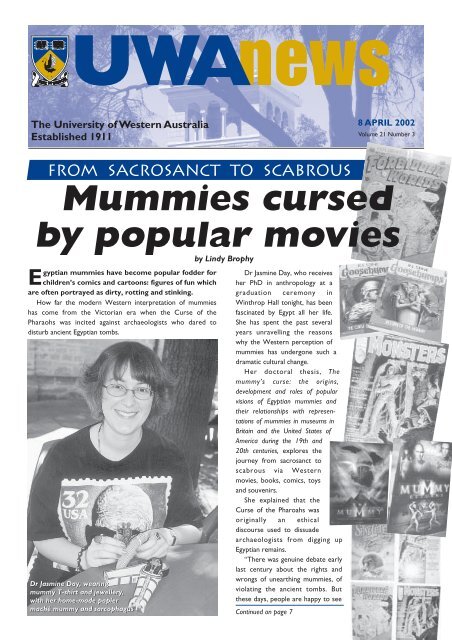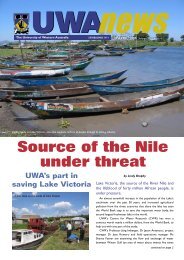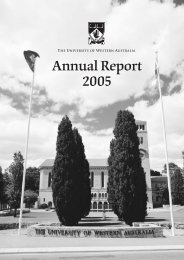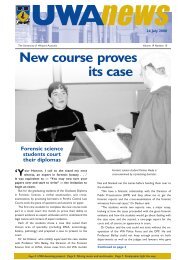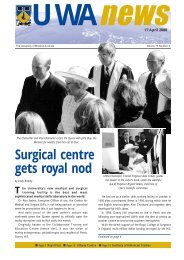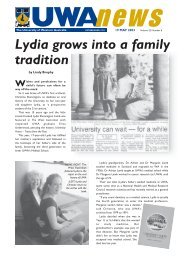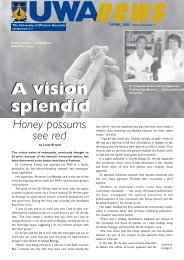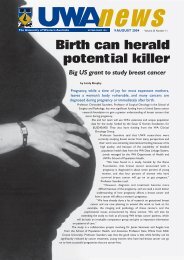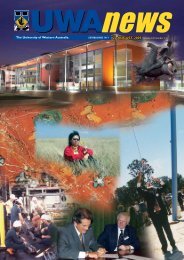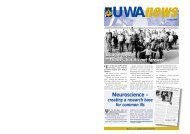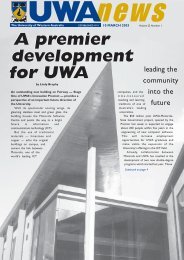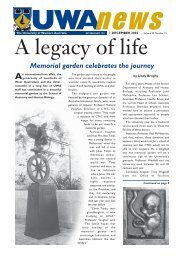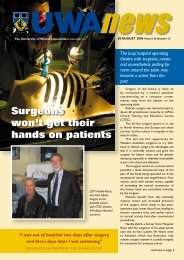8 Apr: Vol 21, #3 - Publications Unit - The University of Western ...
8 Apr: Vol 21, #3 - Publications Unit - The University of Western ...
8 Apr: Vol 21, #3 - Publications Unit - The University of Western ...
Create successful ePaper yourself
Turn your PDF publications into a flip-book with our unique Google optimized e-Paper software.
UWAnews<strong>The</strong> <strong>University</strong> <strong>of</strong> <strong>Western</strong> AustraliaEstablished 19118 APRIL 2002<strong>Vol</strong>ume <strong>21</strong> Number 3From sacrosanct to scabrousMummies cursedby popular moviesby Lindy BrophyEgyptian mummies have become popular fodder forchildren’s comics and cartoons: figures <strong>of</strong> fun whichare <strong>of</strong>ten portrayed as dirty, rotting and stinking.How far the modern <strong>Western</strong> interpretation <strong>of</strong> mummieshas come from the Victorian era when the Curse <strong>of</strong> thePharaohs was incited against archaeologists who dared todisturb ancient Egyptian tombs.Dr Jasmine Day, wearingmummy T-shirt and jewellery,with her home-made papiermaché mummy and sarcophagusDr Jasmine Day, who receivesher PhD in anthropology at agraduation ceremony inWinthrop Hall tonight, has beenfascinated by Egypt all her life.She has spent the past severalyears unravelling the reasonswhy the <strong>Western</strong> perception <strong>of</strong>mummies has undergone such adramatic cultural change.Her doctoral thesis, <strong>The</strong>mummy’s curse: the origins,development and roles <strong>of</strong> popularvisions <strong>of</strong> Egyptian mummies andtheir relationships with representations<strong>of</strong> mummies in museums inBritain and the <strong>Unit</strong>ed States <strong>of</strong>America during the 19th and20th centuries, explores thejourney from sacrosanct toscabrous via <strong>Western</strong>movies, books, comics, toysand souvenirs.She explained that theCurse <strong>of</strong> the Pharoahs wasoriginally an ethicaldiscourse used to dissuadearchaeologists from digging upEgyptian remains.“<strong>The</strong>re was genuine debate earlylast century about the rights andwrongs <strong>of</strong> unearthing mummies, <strong>of</strong>violating the ancient tombs. Butthese days, people are happy to seeContinued on page 7
2 UWAnewsVCariousthoughts …Power<strong>The</strong><strong>of</strong>OneShould Australia be developing one ‘world class<strong>University</strong>’ as a focus <strong>of</strong> national policy?Just at the time when there is much critical comment over thedecline in significant competition in the national airline sector— with effectively only one major courier remaining — so thehigher education sector is being urged to concentrateexcellence in one (or two) institutions.<strong>The</strong> idea has appeal in certain business and policy circles asAustralia begins to feel the challenges <strong>of</strong> internationalcompetitiveness in the globalknowledge revolution. And asissues <strong>of</strong> scale and resources hithard, in measuring the gap whichour universities face in aspiring towork at an international level <strong>of</strong>excellence, so it is tempting toadopt a simple strategy <strong>of</strong> concentration.But as with many simple responses to complex issues, this ideais flawed at many levels. In a recent article in the HigherEducation Supplement <strong>of</strong> <strong>The</strong> Australian (13 March 2002) Iattempted to set out the major problems in any such policyinitiative. To those general reservations let me here add myconcerns for WA and for UWA.Yes, it would benefit our whole sector to enjoy the halo effect<strong>of</strong> having at least one ‘world beating university’. But at whatprice? Distorting national funding in a narrow focus will hardlyproduce the diverse sector <strong>of</strong> excellence that a diverse modernsociety requires.Distorting national funding in a narrow focus willhardly produce the diverse sector <strong>of</strong> excellencethat a diverse modern society requires.Likewise, choosing as a model the <strong>of</strong>ten cited instances <strong>of</strong>Oxbridge or the US Ivy League ignores not only the vast gap inthe historic endowments <strong>of</strong> ancient (and private) universities,but presumes that they are exactly what a modern Australianeeds. As many <strong>of</strong> our leading universities have built strategiclinkages and partnerships internationally, we have especiallycome to value the innovative and entrepreneurial neweruniversities <strong>of</strong> Europe and North America.Such universities have also come to achieve excellence throughcompetitive environments, they have carefully focussed missionswithin a range <strong>of</strong> institutions, and they have also become ‘hybriduniversities’ through a strong diversification <strong>of</strong> funding —including major industry and pr<strong>of</strong>essional alliances.Deliberately creating a tall poppy institution policy moreoverhas some extraordinary federal or regional consequences. Is itfeasible to imagine that the focus <strong>of</strong> such a strategy would beother than eastern Australia, or even the Sydney/Canberra/Melbourne axis? Would it be likely that Australia’s ‘worldbeater’ university be placed in WA, no matter how excellentour <strong>University</strong>’s research performance in recent years?One <strong>of</strong> the critical aspects <strong>of</strong> Australian society has been amajor recognition <strong>of</strong> regional/state development. And thecapacity <strong>of</strong> a federated system to support regional/statecommunities and their cultures. Both key features <strong>of</strong> a diversenation draw heavily from therole <strong>of</strong> their universities aspowerhouses <strong>of</strong> developmentand community.Since 1911 UWA has fulfilledthat vital role for its Statesociety and is now also a criticalinternational gateway for <strong>Western</strong> Australians as globalisedchallenges and opportunities increasingly shape our lives. <strong>The</strong>UWA Operational Plan has an absolute commitment to‘achieving international excellence’.In short — as a nation we need the kind <strong>of</strong> flexibility in policyframeworks, and the levels <strong>of</strong> contestable funding, which wouldallow world class universities to emerge in an environment <strong>of</strong>open competition.UWA is ready and able to compete in such a de-regulated andcontestable environment.We know the Power <strong>of</strong> One!UWAnewsEDITOR/WRITERLindy BrophyTel.: 9380 2436 Fax: 9380 1192 Email: lindy.brophy@uwa.edu.auEDITOR-IN-CHIEFColin Campbell-FraserTel: 9380 2889 Fax: 9380 1020 Email: cam@acs.uwa.edu.auDesigned and typeset by <strong>Publications</strong> <strong>Unit</strong>, UWAPrinted by UniPrint, UWAUWAnews online: www.publishing.uwa.edu.au/uwanews/Pr<strong>of</strong>essor Deryck SchreuderVice-Chancellor and Presidentvc@acs.uwa.edu.auTHE UNIVERSITY OF WESTERN AUSTRALIA • 8 APRIL 2002
UWAnews 3Alzheimer’s, that insidious disease thatindiscriminately robs the minds <strong>of</strong> elderly people,is coming closer every year to being obliterated.Already, there are drugs available to treat the symptoms <strong>of</strong>Alzheimer’s and, in the opinion <strong>of</strong> Associate Pr<strong>of</strong>essor RalphMartins (pictured right), in 10 years’ time, it is very likely that therewill be drugs available that can treat the cause <strong>of</strong> the disease.Ralph Martins is the Director <strong>of</strong> the Sir James McCuskerAlzheimer’s disease research unit at Hollywood PrivateHospital, and an Associate Pr<strong>of</strong>essor in the UWA Department<strong>of</strong> Surgery.He and his colleagues around the world, but especially his labat Hollywood, have made extraordinary progress over the pastdecade.His research team is short <strong>of</strong> space (there are 15 <strong>of</strong> themworking at Hollywood Private Hospital) and short <strong>of</strong> money,despite the generous patronage <strong>of</strong> the McCusker family. But ithasn’t prevented them from making huge strides in theunderstanding <strong>of</strong> Alzheimer’s.<strong>The</strong> first steps were made in 1985 when a research teamfrom UWA under Pr<strong>of</strong>essor (then Dr) Colin Masters found thatdeposits known as senile plaques seen in the brains <strong>of</strong>Alzheimer’s patients were composed <strong>of</strong> a new type <strong>of</strong> protein,which they called beta amyloid.Alzheimer’sBrilliant mindstake on themind robber“… nearly a hundred years afterAlzheimer’s was identified, it’s still notpossible to give a definite diagnosis —why most people get it is still a mystery”Researchers are now experimenting with ways <strong>of</strong> controllingthe formation <strong>of</strong> these beta amyloid deposits in the hope <strong>of</strong>preventing or even curing the disease.“But even now, nearly a hundred years after Alzheimer’s wasidentified, it’s still not possible to give a definite diagnosis whilethe patient is still alive,” Pr<strong>of</strong>essor Martins said.“Why most people get it is still a mystery. For the vastmajority <strong>of</strong> the population, there’s no way <strong>of</strong> predicting who isat risk.“We need to know the molecular factors that cause theformation <strong>of</strong> beta amyloid and the leading scientist in this field isPr<strong>of</strong>essor Sam Gandy from New York <strong>University</strong>.”Pr<strong>of</strong>essor Gandy has been working with Ralph Martins’ teamand spent time at UWA as a Raine visiting pr<strong>of</strong>essor in 2000.Together, they discovered that sex hormones play an importantrole in reducing beta amyloid. Hormone replacement therapy isnow considered as a possible key to controlling or eveneradicating the disease though further research is needed toestablish its clinical significance.“When to start drug therapy is so important,” Pr<strong>of</strong>essorMartins said. “Memory clinics have now been set up in mostcities in Australia so people with symptoms <strong>of</strong> Alzheimer’s arediagnosed early.Pr<strong>of</strong>essor Martins said that controlling cholesterol could helpprevent Alzheimer’s. <strong>The</strong> APOE gene, which is a major high riskContinued on page 4Probably one <strong>of</strong> the most beneficial projects undertaken byPr<strong>of</strong>essor Martins recently is his media fellowship at the ABC inSydney.Each year the ABC trains carefully selected leading scientists tounderstand and work the media, for the benefit <strong>of</strong> themselves,their research teams and universities and also the ABC, who thenhas a steadily building team <strong>of</strong> expert commentators with soundknowledge <strong>of</strong> how the media works.Pr<strong>of</strong>essor Martins was chosen for a six-week fellowship late lastyear and, although he found it difficult to drag himself away fromhis work, he took some long service leave, believing it wouldbenefit his research.By the end <strong>of</strong> the course, he was presenting a program onAlzheimer’s on Robin Williams’ Science Show on ABC Radio.After Christmas, he gave a series <strong>of</strong> public lectures in the US atwhich he said he felt much more relaxed and confident than heever had before at a public lecture, and last month, he gave along interview to Perth journalist Norman Aisbett for <strong>The</strong> WestAustralian’s big weekend.“<strong>The</strong> fellowship helped me enormously with that interview. Afterit was published, we had a huge response. And that’s where Ithink the course at the ABC will best work for me: by becoming abetter communicator and learning about media opportunities andhow to take advantage <strong>of</strong> them, I have opened the door toattracting more funding.”Communication skills are the key to that door.THE UNIVERSITY OF WESTERN AUSTRALIA • 8 APRIL 2002
4 UWAnewsDeputy Vice-Chancellor Pr<strong>of</strong>essor Alan Robson meets some <strong>of</strong> the new equity and diversity advisers: Claire Webb, Penny Van Reenen,Dr <strong>The</strong>lma Koppi, Dr Allan Goody and Maureen RussellNow available: diverse advice<strong>The</strong> 16 new equity and diversity advisers were Sometimes people don’t want to go to somebody who worksguests <strong>of</strong> the Vice-Chancellor for a special too closely with them.morning tea on Harmony Day.“<strong>The</strong>y can tell you what course <strong>of</strong> action is available to you,<strong>The</strong> Equity and Diversity Office, which organised activities and it may not fall within the equity/diversity framework,” shefor Harmony Day, was pleased that the staff members who had said.recently been inducted were recognised by the Vice-Chancellor Ms Hill said the idea <strong>of</strong> the advisers was to empower peopleon a day devoted to living in harmony with our fellow men and to resolve matters at the lowest possible level, quickly andwomen, exactly what the advisers are promoting.sensitively.Of the 16 new advisers, eight have previously been sexual Posters identifying the new advisers are no going up aroundharassment or equity <strong>of</strong>ficers. <strong>The</strong>ir brief is now broader and campus and information about them is also available on theall <strong>of</strong> them attended a two-day training course, opened and Web.supported by Deputy Vice-Chancellor, Pr<strong>of</strong>essor Alan Robson. “It’s not just about compliance,” said Ms Hill. “We have proactivestrategies in place. And if anybody has some good ideas“<strong>The</strong>y are people on campus who can listen sensitively,without prejudice and give sensible advice,” said Beverley Hill, about promoting equity and diversity, they can approach anthe <strong>University</strong>’s acting manager <strong>of</strong> Equity and Diversity.adviser. <strong>The</strong>re is some funding available for small projects, like“<strong>The</strong>se advisers are working throughout the <strong>University</strong> and posters or providing relief for somebody while they attend aanybody who has a problem can contact any one <strong>of</strong> them. course.”Continued from page 3Alzheimer’sgene associated with the disease, alsocarries fat and cholesterol around thebody.He said that people still fearedaluminium could cause Alzheimer’s butit now seemed unlikely. Recent studiesshow that aluminium identified in thebrains <strong>of</strong> patients now appears to haveresulted from contaminants in the lab.However, the publicity given toaluminium pots and pans has stuck inAssociate Pr<strong>of</strong>essor Ralph Martins: “Youhave to be passionate about your researchbecause, for the first few years, you’re justbanging your head against the wall”people’s minds. <strong>The</strong> amount <strong>of</strong>aluminium coming in through the diet orthe use <strong>of</strong> deodorants is much higherthan from pots and pans but is notassociated with disease ,” he said.<strong>The</strong> McCusker Foundationlaboratories are currently hosting avisiting pr<strong>of</strong>essor <strong>of</strong> neurology fromChina for 12 months and later this year,a visiting post-doctoral fellow from Italywill join the team for six months. <strong>The</strong>sevisitors are self-funded.If you would like to make a donation ora bequest to the McCusker Foundation,the phone number is 9346 6312.THE UNIVERSITY OF WESTERN AUSTRALIA • 8 APRIL 2002
UWAnews 5Long-distance musicsoundssweetestImprovising a piece <strong>of</strong> musictakes special talent, andteaching improvisation isanother level up.Teaching improvisationacross the world via theInternet is a dream <strong>of</strong>senior music lecturer,Dr Sam Leong, and his latestwork with visiting Pr<strong>of</strong>essor Fred Reeves from Indiana<strong>University</strong> is bringing that dream a step closer to reality.Pr<strong>of</strong>essor Reeves, Head <strong>of</strong> Graduate Studies at Indiana<strong>University</strong> at Indiannapolis, teaches a unique course, a Masters<strong>of</strong> Science in Music Technology. Dr Leong is an adjunctpr<strong>of</strong>essor at Indiana, working with Pr<strong>of</strong>essor Reeves on theonly music course <strong>of</strong> its kind in the world. While he was atUWA, consulting with Dr Leong on his music s<strong>of</strong>tware,Pr<strong>of</strong>essor Reeves was able to keep up his teaching, from theother side <strong>of</strong> the world.Using AARNET, Australia’s high band Internet system,Polycom s<strong>of</strong>tware and a ViaVideo camera, Pr<strong>of</strong>essor Reeveswas able to deliver a lecture in real time to his students, whocould see and hear him as clearly and smoothly as if he was inthe classroom. He could see and hear them, with the cameraautomatically zooming into whichever student who asked aquestion. “I was blown away when I could see the students andinstruct them how to use my s<strong>of</strong>tware,” Dr Leong said.“This new technology has exciting implications for teachingstudents in Albany, Kalgoorlie and Geraldton. <strong>The</strong>re is less thanhalf a second’s delay between Perth and Indiana, so the deliveryMurderweekendfor expertsABOVE: Dr Sam Leong andPr<strong>of</strong>essor Fred Reeves teach aclass in Indiana — from an<strong>of</strong>fice in PerthLEFT: <strong>The</strong> camera that sendstheir images across the worldis far superior to any system usedbefore. And it’s more flexible andcheaper than conventional videoconferencing.Once you’re connected to the Internet,it’s practically free,” he said.Dr Leong is on sabbatical leave this year, concentrating ondeveloping diagnostic and metacognitive s<strong>of</strong>tware, and writingand exploring flexible delivery for the music education coursesat UWA.His s<strong>of</strong>tware, developed with Dr Martin Lamb from the<strong>University</strong> <strong>of</strong> Toronto, over the past two years, is designed tohelp students find new and better ways <strong>of</strong> improving their auralskills. His research, funded by a grant from the Committee for<strong>University</strong> Teaching and Staff Development and an ARC smallgrant, will be presented at an international music educationconference in Norway in August. He is also working at thecommercialisation stage in the development <strong>of</strong> his aurals<strong>of</strong>tware and hopes to launch it as shareware later this year.“With livestream lecturing so easily and economicallyavailable, the next thing Pr<strong>of</strong>essor Reeves and I would like to dois try the challenge <strong>of</strong> teaching performance and improvisation,”Dr Leong said. “It’s so exciting and it’s something that willbenefit all students who are remote from the campus because itcan be used in any discipline.”This year marks a milestone in the legal history <strong>of</strong> WA. For the firsttime police will be allowed to use a suspect’s DNA in a criminalinvestigation.<strong>The</strong>y will also be able to check DNA pr<strong>of</strong>iles against unsolved crimes. Will some <strong>of</strong>our most baffling cases be re-opened and solved? Is this realistic or is this newtechnology vastly over-rated? UWA’s Centres for Forensic Science and CrimeResearch present a weekend seminar, DNA – An Effective Contribution to Justice?To be held at Rottnest Island from May 3 to May 5, the seminar brings together fourinternational experts in DNA. David Richards, Head <strong>of</strong> the National Crime Faculty inthe UK and Dr David Barclay, Chief Forensic Scientist, Forensic Science Services, UK, will join Judith Fordham, a WA barrister who iscurrently studying for her PhD in forensic science and who lectures internationally on the presentation <strong>of</strong> expert evidence in court. <strong>The</strong>fourth expert, Robin Napper, the Director <strong>of</strong> Research and Development at UWA’s centre for Forensic Science, is a former DetectiveSuperintendent from the UK who was instrumental in introducing the use <strong>of</strong> DNA to most other Australian states.What has been the experience <strong>of</strong> other countries? What is the real story behind the first intelligence-led DNA screen in Australiaat Wee Waa? Answers to these and other questions will emerge at the seminar.THE UNIVERSITY OF WESTERN AUSTRALIA • 8 APRIL 2002
6 UWAnewsGRADUATIONSFallingAs the autumn leaves start to fall, the <strong>University</strong> has its own way <strong>of</strong> marking the change<strong>of</strong> season — the first <strong>of</strong> the year’s graduation ceremonies.Tonight, 396 graduands will receive degrees in architecture, landscape architecture, visual arts,social sciences, the arts and humanities. By far the biggest group among them will be the <strong>21</strong>5leaves,Bachelors <strong>of</strong> Arts, followed by 50 newly-qualified social workers.Over the next ten days, a total <strong>of</strong> 2,247 degrees and diplomas will be conferred across sixgraduation ceremonies. Among them are 65 new Doctors <strong>of</strong> Philosophy, and the biggest singlegroup <strong>of</strong> first degree graduands, 338 Bachelors <strong>of</strong> Commerce. This year, there are 108 new medicalrustling gownsdoctors, each receiving their MB BS and 150 lawyers, graduating withBachelors <strong>of</strong> Laws. <strong>The</strong> Graduate School <strong>of</strong> Management has passed 94Backyardcultivationproducesa PhDDr Andrea Gaynorin her UWA<strong>of</strong>fice gardenstudents as Masters <strong>of</strong> Business Administration.<strong>The</strong> idea <strong>of</strong> Australians producing food in theirbackyards because they couldn’t afford to buy it islargely a 20th century myth.Dr Andrea Gaynor, who receives her PhD in history at thefirst <strong>of</strong> this year’s graduation ceremonies, studied people’srelationship to the environment by looking at the history <strong>of</strong>suburban food production in Perth and Melbourne.While many suburban Australians are now subdividing theirland and building houses in their backyards, Dr Gaynor says it issurprising how many people still grow fruit and or vegetables ontheir suburban blocks.“<strong>The</strong> keeping <strong>of</strong> poultry has greatly diminished but, accordingto the statistics I used (which are now ten years old), I guessthat between 40 and 50 percent <strong>of</strong> Perth households and from50 to 60 per cent <strong>of</strong> Melbourne households produce some <strong>of</strong>their own fruit and vegetables,” said Dr Gaynor, who is now alecturer in History at UWA.Her research showed that backyard food production wasnot usually carried out for reasons <strong>of</strong> economic necessity andwas, in fact, most prevalent among the middle class, who hadthe space and security <strong>of</strong> tenure.“During the Depression, for example, the people who mostneeded to grow their own food were <strong>of</strong>ten fleeing fromlandlords, unable to pay their rent. <strong>The</strong>y didn’t have the luxury<strong>of</strong> staying in one place long enough to grow their own food.”She found that home food production became a symbol <strong>of</strong>independence for middle-class home-owners. “Like homeownership, which showed they were independent <strong>of</strong> landlords,growing some <strong>of</strong> their own food allowed them to think <strong>of</strong>themselves as independent producers rather than dependentconsumers” Dr Gaynor said.She did some modelling on quantities and proportions <strong>of</strong>productive households, based on statistics from the AustralianBureau <strong>of</strong> Statistics, and found that if around a third <strong>of</strong>households in Perth and Melbourne grew some <strong>of</strong> their ownfruit, the average quantity produced per household would havebeen around 35kg in 1992. Average vegetable productionprobably ranged from 47kg to 51kg.“I also found that although keeping chooks wasn’t as popularin the 1990s as it had been earlier in the century, morehouseholds in Perth kept them, whereas more households inMelbourne grew vegetables.“I put this down to the dry hot summers and sandy soil inPerth which make it very difficult to keep crops going over thesummer,” she said.Dr Gaynor is teaching Australian Studies and next semestershe will run a course on aspects <strong>of</strong> Australian culture and the rise<strong>of</strong> suburbia, in which she will draw on the work in her thesis.THE UNIVERSITY OF WESTERN AUSTRALIA • 8 APRIL 2002
UWAnews 7GRADUATIONSJanet and Sarah Dawson, readyfor the big nightFollowingin Mum’sfootsteps<strong>The</strong>re was no question forSarah Dawson when itcame to choosing a university.“I felt so comfortable and athome at UWA and I knew it wasthe best,” said one <strong>of</strong> tonight’s 233arts graduates.One <strong>of</strong> the reasons for Sarah’simpressions was that her mother,Janet Dawson, had been workingon campus for 10 years. Janet is anadministrator in the Vice-Chancellery. She, like her daughter,has also studied arts at UWA, inthe late 1970s.Sarah, who receives a Bachelor<strong>of</strong> Arts in Linguistics and PoliticalScience, has also worked oncampus. She did some researchwork for Community Relations lastyear and is now contemplatingstarting her Honours thesis midyear.Janet pointed out that this wasthe second time Sarah hadgraduated in Winthrop Hall. Herformer school, St Hilda’s, alwaysholds their speech nights andgraduation ceremonies here.Continued from page 1Mummies cursedmummies on display inmuseums and they nowthink <strong>of</strong> the Curse as alegend, rather than anargument about ethics,” DrDay said.“<strong>The</strong> big question waswhat disempowered theCurse <strong>of</strong> the Pharaohs? AndI began to find the answer inthe writings <strong>of</strong> an Italianacademic in the 1930s, AntonioGramsci’s theory <strong>of</strong> hegemony.“He says that in order to maintainpower, the powers that be, whetherthey are politicians or the mass media,take a phenomenon that is <strong>of</strong> interestto the people, neutralise it to ensure itcan’t incite them, then return it to themin a sanitised form.“<strong>The</strong> mummy’s curse has beenneutralised by the mummy films sopopular in the 1930s and 40s. <strong>The</strong>ybegan with Boris Karl<strong>of</strong>f in <strong>The</strong> Mummyin 1932 and progressed through manyfilms, with the mummy coming alive tovisit the curse on whoever disturbedhim.“<strong>The</strong> pre-classic curse followed thehubris-nemesis pattern but the classiccurse, the curse <strong>of</strong> cinema, extendedthat pattern to hubris-nemesis-revenge.<strong>The</strong> mummy was always defeated in theend.“<strong>The</strong> film industry implied that it wasOK to dig up the dead and turned themummy into a defeatable character (thearchaeologist always won). In contrastto the days when King Tut’s tomb wasdiscovered and people raged against itsviolation, the mummy had been changedfrom victim to villain.”Dr Day studied the plots <strong>of</strong> moviesand television shows (mummies haveeven featured several times inepisode <strong>of</strong> <strong>The</strong> Simpsons),collected hundreds <strong>of</strong> mummytoys and souvenirs frommuseum shops around theworld and bought them fromInternet sites, read books andcomics such as the 1990children’s series <strong>of</strong> novels,Goosebumps, and talked toEgyptologists as well as ordinarypeople visiting Egyptian displaysin museums in England andthe USA.“I had been to Egypttwice before I began myresearch and I didn’t goback there again until I hadcompleted it. I didn’t needto because I wasinterested in the <strong>Western</strong>responses and images. Butwhen I did return last year,I took some <strong>of</strong> my dolls and toys withme and the Egyptians were horrified bythem. Nothing like them is available inEgypt,” Dr Day said.One <strong>of</strong> the most outlandish mummyspin-<strong>of</strong>fs she came across were jellybaby-typelollies called Gummy Mummiesfrom the Mummy’s Tummy!Dr Day found that feminist authorJulia Kristeva’s theory <strong>of</strong> abjection hadalso been applied to mummies. <strong>The</strong>theory groups together anything that isunpleasant and polluting like cruelty,decay, incest and death.“<strong>The</strong> mummy has become abjected.In films and comics there is always lots<strong>of</strong> emphasis placed on dust and smellscoming out <strong>of</strong> the mummy, withunravelling bandages showing rottingflesh and decay. In reality, mummiesdon’t mould and rot as long as they arekept dry. <strong>The</strong> latest image <strong>of</strong> them asfilthy and rotting is in exact oppositionto the truth.“This idea <strong>of</strong> filth could be whymummy toys and characters appeal tochildren, who, although they’re told it isundesirable, love the idea <strong>of</strong> anythingdirty!“<strong>The</strong> post-classic stage <strong>of</strong> the curse,following the great mummy movies, isthat the idea <strong>of</strong> the curse is laughableand the mummy character has passedentirely into children’s culture. <strong>The</strong>curse is no longer a part <strong>of</strong>the mummy story and thereis no reason given for amummy to get up out <strong>of</strong> thetomb and walk. (In earlierfilms and stories, he got upand walked so he couldcarry out the curse.)”Nobody else in the worldhas studied mummy-maniato this extent.THE UNIVERSITY OF WESTERN AUSTRALIA • 8 APRIL 2002
8 UWAnewsLDW runs intodouble figuresAn early LDW planning group: (back) Trish Todd, Judy Fetherstone, Delys Bird, Lyn Abbott,Sarah Mann, Judy Stratton, Marnie O’Neill ; (front) Izan, Maria Osman<strong>The</strong> Leadership Developmentfor Women Program thatstarts next month marks the tenthintake from staff at UWA.Over the eight years since theprogram began, a total <strong>of</strong> 250 women atUWA have benefited from the course,one <strong>of</strong> the most successful run by theCentre for Staff Development.LDW is open to all levels <strong>of</strong> femalestaff who are employed half-time ormore and whose contracts run at leastuntil the end <strong>of</strong> the year in which theprogram starts.To meet the needs <strong>of</strong> all eligiblewomen, two separate programs streamsare now run in alternate years.Jen de Vries, LDW Program coordinator,said that while there were nostipulated levels <strong>of</strong> appointmentrequired for either program, womenwere encouraged to self-selectaccording to their particular needs andwhat would be appropriate for them.<strong>The</strong> 2002 program, for whichapplications are due on <strong>Apr</strong>il 17, isLeadership and Management, designedfor women in leadership roles who arefocusing on developing and exercisingtheir leadership in a broader area.“<strong>The</strong> women we expect will choosethis course will be reasonably wellestablished in their research,academic, administrative, technical orpr<strong>of</strong>essional roles. <strong>The</strong>y will have alarge degree <strong>of</strong> autonomy in theirpositions and may carry responsibilityfor projects or new initiatives, bemanaging teams or units, supervisingothers, or participating in <strong>University</strong>widecommittee or working parties,”Ms de Vries said.Next year’s program is for womenwho are keen to explore theirleadership potential while they areestablishing themselves. Potentialparticipants will be keen to extend theirself-management and leadership skillswithin their current roles as well asexplore future career paths andpossibilties.Applications for that program will becalled later this year.Ms de Vries encouraged heads <strong>of</strong>schools and sections, managers andsupervisors to encourage eligiblewomen staff to apply for the LDWcourses which have made such adifference already to 250 women atUWA.Muffins & maintenance<strong>The</strong> bicycle co-operative has had news that was even better than the freemuffins at their annual Bike to Breakfast recently.<strong>The</strong> co-op, which comprises all bike groups on campus, is setting up a bicycle repairshop in the Recreation Centre where it will run classes on bicycle maintenance and carryout repairs for anybody who cycles to <strong>University</strong>.<strong>The</strong> co-op has been looking into establishing a fleet <strong>of</strong> second hand bicycles for saleor hire around the campus but the legal implications will probably mean the scheme willnot get <strong>of</strong>f the ground.<strong>The</strong> club is also looking for a ‘home base’ somewhere on campus and, depending onthe success <strong>of</strong> the bike repair shop, this too may be established somewhere close by.<strong>The</strong> fifth annual Bike to Breakfast was another great success with about 250 staff andstudents dropping in for free breakfast, water bottles and stickers, a chance to winprizes including two nights at the Esplanade Hotel, and an opportunity to meet othercyclists. <strong>The</strong> morning is sponsored by UWA Sports, the Office <strong>of</strong> FacilitiesManagement, the UWA Cycle Club and the Bicycle Users’ Group (BUG).BUG members cycled from as far away as Kalamunda to support the event.UWA Cycle Club members show how it’s doneTHE UNIVERSITY OF WESTERN AUSTRALIA • 8 APRIL 2002
Law studentssecond inthe worldUWA’s champion law mootingteam has narrowly missed outon first place in theinternational Jessup Mootcompetition.<strong>The</strong> Australian national winnerscame second to the <strong>University</strong> <strong>of</strong>Witwatersrand in a split decision inthe grand final in Washington lastmonth.<strong>The</strong> Jessup Moot competition,which centres on international law,involves 1,500 <strong>of</strong> the best lawstudents from 300 law schoolsthroughout the world.<strong>The</strong> president <strong>of</strong> the Jessup Mootassociation said he had been part <strong>of</strong>the finals for the past 16 years andthis was the highest standard moothe had ever seen.Lorraine Van Der Ende wasawarded best mooter in the grandfinal and she also finished third bestoralist overall in the preliminaryrounds. Another UWA teammember, Lee Carroll, who wasawarded best oralist in theAustralian national competition, wassixth best oralist in the preliminaryrounds. <strong>The</strong> team’s written workreceived a score <strong>of</strong> 97% comingthird.Others in the team, made up <strong>of</strong>fourth and fifth year law students,are Ben Gauntlett, Julie Taylor andAdam Sharpe with coach JamieEdelman, a UWA graduate andRhodes scholar.Congratulations to them and theirsupporters in the Law School fortheir marathon effort and brilliantresults.UWAnews 9A not toosympatheticbiographerWhen UWA historianRichard Bosworth set outto write a biography <strong>of</strong> Mussolini,he was warned that he wouldbecome too sympathetic towardsthe Italian leader.“But now the book is written, I donot believe that I have weakened in myhostility to fascism,” Pr<strong>of</strong>essorBosworth (pictured) said.His book, Mussolini, the first majorbiography <strong>of</strong> Benito Mussolini since theend <strong>of</strong> the Cold War, was launchedrecently at the Imperial War Museum inLondon.Pr<strong>of</strong>essor Bosworth is a leadinghistorian <strong>of</strong> 20th century Italy and hisbiography is expected to create newdebate about the role <strong>of</strong> Mussolini inItalian politics.His portrait is described as a subtleand complex one that captures themultiple strengths, flaws andcontradictions <strong>of</strong> Mussolini’s personalityand <strong>of</strong> a remarkable political career thatspanned the most traumatic moments<strong>of</strong> the 20th century.“I have loved the writing. I amnotoriously a person who finds trueFamily linkwith mootcourtRichard and Hilary Lane withBill Ford (centre) in the mootcourt named after their relativeFrom engineer to magistratemight seem an unusualprogression.But for Lambden Owen, aLincolnshire engineer who arrived inAustralia in 1886, it meant a fascinatingaddition to his career. And it alsoresulted in a greatly appreciatedaddition to the Law School.Lambden Owen, at various timesWarden <strong>of</strong> the Pilbara and CoolgardieGoldfields, Resident Magistrate in Menzies,happiness in a nice sentence. Of all mybooks, Mussolini was the most fun towrite, probably because I was aware <strong>of</strong>writing for a considerable audience andnot only for other academics,”Pr<strong>of</strong>essor Bosworth said.Mussolini is published by Oxford<strong>University</strong> Press.the Wellington district and Perth, has aMoot Court named after him.His niece, Edith Stewart Gordon, left abequest to the Law School in 1976, withthe specific instruction that it be used toconstruct a moot court for law students.Last month, Warden Owen’sbiographer Richard Lane and his wifeHilary visited from England andinspected the moot court with the Head<strong>of</strong> the Law School, Bill Ford. Mrs Lane isrelated to Warden Owen.THE UNIVERSITY OF WESTERN AUSTRALIA • 8 APRIL 2002
10 UWAnewsIn memory <strong>of</strong> a maritime scholar<strong>The</strong> personal library <strong>of</strong> the latePr<strong>of</strong>essor Frank Broeze hasbeen acquired by the Library.As well as maintaining a remarkablyproductive record <strong>of</strong> research andpublication at UWA, Pr<strong>of</strong>essor Broeze,a leading international scholar in thefield <strong>of</strong> maritime history, served asPresident <strong>of</strong> the InternationalCommission <strong>of</strong> Maritime History and asDeputy Chair <strong>of</strong> the Board <strong>of</strong> the<strong>Western</strong> Australian Maritime Museum.<strong>University</strong> Librarian, John Arfield,described Pr<strong>of</strong>essor Broeze as adedicated teacher who inspiredgenerations <strong>of</strong> students with hisenthusiastic approach to modernhistory.He said Pr<strong>of</strong>essor Broeze’s personallibrary reflected these interests andactivities and contained a wide range <strong>of</strong>books, journals and papers relating tomaritime history and shipping, as well asmore general books on modern politicaland economic history. A particularlyimportant aspect <strong>of</strong> the collection wasits considerable amount <strong>of</strong> Dutch andGerman material, including books onearly Dutch commerce, and on the port<strong>of</strong> Hamburg.He said the Library had a specialinterest in developing its strong collectionson the maritime and commercialhistory <strong>of</strong> the Indian Ocean region.<strong>The</strong> new acquisition – to be knownas the Frank Broeze Memorial Library –will be housed in the Scholars’ Centre,where it will complement the ErulkarCollection, which contains rare booksand manuscripts relating to IndianOcean commerce in the colonial period.“This is a significant acquisition whichis a major addition to our researchcollections and will be <strong>of</strong> great value toresearchers. It will also provide a mostfitting memorial to an outstandingscholar,” Mr Arfield said.Six books and then<strong>The</strong> number six is an auspiciousone for UWA Press this year.Already, they have six new titles incirculation since the beginning <strong>of</strong> 2002,with a further six due to appear overthe next six weeks.Children <strong>of</strong> the Shadows: Voices <strong>of</strong> theSecond Generation is a collection <strong>of</strong>personal reflections on growing up in ahome touched by the shadow <strong>of</strong> theHolocaust. It is the first time such acollection has been published inAustralia. It is edited by Kathy Grinblatand is for sale for $34.95 (paperback)and $45 (hardback).<strong>The</strong> story <strong>of</strong> a loyal pet dog, a bestmate, rabbit trapping after school, ahorrible headmaster, adventures on abike, summer heat and bushfire are allelements <strong>of</strong> Bodger, a novel by PeterJeans, set in the Australian bush in the1940s.It is described as a heart-warmingtale about a boy and his dog (Bodger),based on the author’s own childhoodexperiences and adventures. It ispublished under the Cygnet imprint, foryoung readers’ fiction and is available inpaperback for $14.95.Pr<strong>of</strong>essor Ken Clements, theDirector <strong>of</strong> UWA’s Economic ResearchBodger by Peter Jeans — set to becomean Australian classicCentre, has made some provocativeproposals for the reform <strong>of</strong> energypolicy in WA in his newest publication,<strong>The</strong> Great Energy Debate: Energy Costs,Minerals and the Future <strong>of</strong> the <strong>Western</strong>Australian Economy.six moreWith decisions about future energypolicy imminent, this book provides atimely analysis <strong>of</strong> the importance <strong>of</strong>energy costs to the entire state. It ispublished in paperback and sells for$39.95.A collection <strong>of</strong> essays takes thereader back to the early modern periodin A Touch <strong>of</strong> the Real: Essays in EarlyModern Culture In Honour <strong>of</strong> StephenGreenblat.Edited by Philippa Kelly, thecollection addresses in particular theworks <strong>of</strong> Shakespeare, and asks howhistorical texts might be seen tointerplay with identity. It is for sale for$38.95 (paperback).UWA Press has also recentlypublished Built on Faith: A History <strong>of</strong> PerthCollege for Perth College, and While WeLive, Let Us Live: From <strong>University</strong> Hostel toCurrie Hall, 1942 – 1999. <strong>The</strong>se twobooks are available only from PerthCollege and Currie Hall.<strong>The</strong> others are on the shelves at theCo-op Bookshop and the Visitors’Centre on campus and are also availableat UWA Press, on the corner <strong>of</strong> MountsBay Road and Crawley Avenue.THE UNIVERSITY OF WESTERN AUSTRALIA • 8 APRIL 2002
UWAnews 11Expo’s on —rain or shineA tower-to-tower steeplechasewill be one <strong>of</strong> the highlights <strong>of</strong> the<strong>University</strong>’s inaugural Expo onAugust 25.This will be a fun run from the BellTower in the city to the clock tower inWinthrop Hall, to mark the Expowhich will take the place <strong>of</strong> the OpenDay and the Prospective Students’Evenings.Ian Lilburne, UWA’s special projectsmanager, will co-ordinate the event,bringing his extensive experience <strong>of</strong>Open Days to the Expo.“This time, we are anticipating thatit will rain and working from thatpremise!” he said.He already has a committee workingon the details. <strong>The</strong>se includecommunity activities to get the publicinvolved, both on and <strong>of</strong>f the campus.“We decided to combine the OpenDay and the Prospective Students’Evenings to give staff less work and tobuild on the strengths <strong>of</strong> both <strong>of</strong> thoseevents,” Ian said.For information on the Expo, callProspective Students on 9380 2477,and keep reading UWAnews forupdates each fortnight.secretsC A M P U SWanna race? — Olympic swimmers, Jonno van Hazel and Rachel Harris at the Uniswim poolMost people know there is a swimming pool at Human Movement andExercise Science. But did you know YOU could use it?<strong>The</strong> pool is open for convenient daily exercise from 6am to 7.45am on Monday,Wednesday and Friday, from 11.30am to 2pm on Monday, Tuesday, Thursday andFriday, and from 12noon to 2pm on Wednesday, Saturday and Sunday.It’s open to the public as well as staff members so if you want to meet a friend whodoesn’t work at UWA and have a lunchtime swim together, you can.It costs $2.20 and if you plan on swimming regularly, you can buy 12 tokens for $20,a much better saving than most commercial or council-run swimming pools <strong>of</strong>fer. Youcan also get a season pass for $250 ($150 for pensioners) which allows you to swim as<strong>of</strong>ten as you like all year.Uniswim runs adult squads for grown-ups who want help with their style andlessons for those who want to learn to swim from scratch. <strong>The</strong>re are special squads forthe over-50s. For more information about squads and lessons, please call Robyn on9380 2277.Make the most <strong>of</strong> the heated Uniswim pools and keep fit over winter.If you have a secret spot on campus, a favourite feature or a little-knownfact to share, please send it to us: lindy.brophy@ uwa.edu.au or phoneextension 2436, fax 1192.Pr<strong>of</strong>essor Cheryl Praegerhas recently been electedas one <strong>of</strong> the three academicstaff members <strong>of</strong> the <strong>University</strong>Senate.But she is not a newcomer toSenate. Pr<strong>of</strong>essor Praeger served aterm on Senate from March 1997 toMarch 2001.Her term is for another fouryears and she takes over fromPr<strong>of</strong>essor Terry Quickenden.Continued from page 12<strong>The</strong> Last Wordin HM&ES at $50,000 a year, that’s $3million!So, with governments directingresearch funds so stringently, oneshould beware <strong>of</strong> just following theircues. Governments come and go,universities are here for the longer termand we should fight for thespontaneous, creative, outside thesquare, basic functions for thebetterment <strong>of</strong> humankind — not fit intoa government formula.Eighty per cent <strong>of</strong> our clients/customers are undergraduates whocontribute immensely to the local, stateand national communities. <strong>The</strong>refore, 80per cent <strong>of</strong> our human and technicalresources should be directed tonurturing that group to maximise thebenefits they can provide.Change we must but, selectively, notblindly. Smokescreen change is not new:“We trained hard … but it seemedthat every time we were beginning t<strong>of</strong>orm up into teams we would bereorganised … I was to learn later in lifethat we tend to meet any new situationby reorganisation; and a wonderfulmethod it can be for creating theillusion <strong>of</strong> progress while creatingconfusion, inefficiencies anddemoralisation!” Petronius (65AD) Romanscholar and military leader.Is there anyone out there with astaff:student ratio <strong>of</strong> 1:14? We’d like abit <strong>of</strong> that action!THE UNIVERSITY OF WESTERN AUSTRALIA • 8 APRIL 2002
12 UWAnewsPlus ça change —plus c’est la même chosePr<strong>of</strong>essor Brian BlanksbyHead, Human Movementand Exercise ScienceArecent newspaper article, How We Have Changed1971 – 2001, just about matches up with my timeat UWA.In 1970, I was 28 with a love <strong>of</strong> the beach and all thingsswimming - so life was good with a joint appointment inAnatomy and Physical Education. Being young and invincible,“those people who thought they knew everything annoyedthose <strong>of</strong> us who did.”Teaching was big then and I lined up for 20+ hours per week.Staff:student ratios were 1:10 or thereabouts. Of coursechanges were around at that time. Anatomy changed its nameto Anatomy and Human Biology, and Physical Education andRecreation became Human Movement and Exercise Science(HM&ES). I suppose the words were important becausemeanings do change regularly but, sometimes, it confuses ratherthan clarifies issues. For example, when I was a child, beinghappy on the grass meant you were out playing on the lawn!<strong>The</strong>re was less pressure then becausethe staff:student ratios were moremanageable. Of course we still complainedand one Vice Chancellor even told me wehad a divine right to complain — althoughwhat was done about it was anothermatter. <strong>The</strong>n, another Vice Chancellor toldme we were expected to do considerablymore with considerably less — what a wiseprophet he turned out to be!<strong>The</strong>n came another change when we hadto become more business-like and wordssuch as mission statements, clients andcustomers appeared. I suppose a bit <strong>of</strong> goalsetting and focussing never went astray.During the 80s I was the Head <strong>of</strong>HM&ES, and in that period we had theamalgamation/devolution changes whichused up a lot <strong>of</strong> emotional energy onvarious proposals, most <strong>of</strong> which neverhappened. Mark Twain said somethingabout that: “Some terrible things havehappened in my lifetime, and some <strong>of</strong> them have actuallyhappened”.<strong>The</strong> 90s were much more pleasant for me while performing asomewhat quieter role <strong>of</strong> teaching classes and writing researchpapers. In 2001, my friends and colleagues (at least I thoughtthey were), suggested I do a ‘Nelly Melba’ and step back intothe Head <strong>of</strong> School role for a final stint before retirement.Well, a return to the meeting circuit revealed ‘plus çachange …’, and that we still had the same problems, but theywere worse. For example, now HM&ES has a staff student ratio<strong>of</strong> 1:22 and several departments in the faculty spend more than100 per cent <strong>of</strong> their income on fixed salaries and are graduallydisappearing down the gurgler via incremental creep!What has this government done to us? About 15 years agowe had a few international students here under such schemes asthe Colombo plan. Currently, education is Australia’s fifthhighest export earner. And, still they cut, cut, cut.One is reminded <strong>of</strong> the Ardmona fruit commercial on TV afew years back in which Rod Marsh juggled, then dropped thecan <strong>of</strong> peaches. I told someone that I had heard he was paid$5000 for that commercial and the response was: “Cripes, whatwould they have paid him if he had caught it?”Doesn’t one feel a bit that way about the success universitieshave made <strong>of</strong> the education export industry? Maybe we shouldhave ‘dropped the peaches.’ We have picked up so many extratasks outside core business (largely marketing andadministration at which we are untrained) which are completelyignored by our funding fathers in the East — tasks whichmysteriously but regularly just materialise. <strong>The</strong> increase in paperwarfare in an era <strong>of</strong> the supposed ‘paperless <strong>of</strong>fice’ isnonsensical. What size army is required to sift through it, letalone interpret. All in the name <strong>of</strong> accountability. Hell though,it’s good for the ACT economy to hire all these people tocollect and archive materials which will not help anyone but willprovide a focus point from which to hold an enquiry whensomething goes pear shaped — <strong>of</strong> course, always after theevents they were supposedly employed to prevent.I sometimes think the mistake we made was to make a success<strong>of</strong> it and so the government has decided to squeeze more andmore. Rather than being rewarded for self-help, it seems that“make yourself a donkey and we’ll ride you into the dirt” .Down here in HM&ES, at the true epi-centre <strong>of</strong> campus onthe river bank, we have changed enormously over my 32 years.<strong>The</strong> only remaining certainty is change but it needs controllingand balance.‘Switching on’ undergraduate students to scientific endeavourprovides a heap <strong>of</strong> young, talented Honours and PhDresearchers working under careful, passionate and dedicatedsupervision for efficient and effective research output. About 60Continued on page 11t h elast wordTHE UNIVERSITY OF WESTERN AUSTRALIA • 8 APRIL 2002
infoUWAnewsResearch&GrantsContractsUWA SMALL RESEARCH GRANTSDr Kieran Dolin, English: “An introduction tolaw and literature” – $12,013 (2001).Dr Brenda Walker, English: “A critical examination<strong>of</strong> the auditory in Poe’s fiction” – $11,152(2002).A/Pr<strong>of</strong> Andrew Hunwick, European Languages& Studies: “<strong>The</strong> founding <strong>of</strong> biblical criticism inseventeenth-century France” – $5525 (2002).Dr David Denemark, Political Science: “Populistpolitics in Anglo-American democracies: Buildinga cross-national model <strong>of</strong> political change” –$7006 (2002).Dr Bruce Stone, Political Science: “Proceduralchange in the Upper House <strong>of</strong> Australian StateParliaments” – $5777 (2002).Dr David Van Mill, Political Science: “Amempirical test <strong>of</strong> social choice and deliberativetheories <strong>of</strong> democracy” – $4000 (2002).Mrs B. Clare, Social Work & Social Policy:“Making children visible: Mapping the early stages<strong>of</strong> the care journey” – $6825 (2002).Mr Mark Holub, Mr Alexander Clarke andDr Juliana Kam-Leng Ng, Accounting &Finance: “<strong>The</strong> theory and practice <strong>of</strong> corporatefinance in Australia” – $3000 (2002).Dr Chong Man James Lau, Accounting &Finance: “<strong>The</strong> effect <strong>of</strong> manufacturing andmanagement accounting innovations onorganisational performance” – $9,464 (2002).Dr Nicholaas Groenewold, Economics:“International transmission <strong>of</strong> share-pricechanges: Fundamentals or speculation?” –$11,290 (2002).Dr Moonjoong Tcha, Economics: “Australia andAsia - What kind <strong>of</strong> neighbours?” – $15,864 (2002).Dr Yanrui Wu, Economics: “Measuringeconomics openness and its impacts on growth:With application to the Chinese regions” –$19,057 (2002).Dr Reinout de Vries, Organisational & LabrStudies: “Leadership and shared mental models”– $19,686 (2002).Dr Anne Chapman, A/Pr<strong>of</strong> ThomasO’Donoghue and Dr Marilyn O’Neill, GSE:“Developing a model for pr<strong>of</strong>essional developmentin cross-curricular numeracy teaching inWA middle schools” – $12,412 (2002).A/Pr<strong>of</strong> Stephen Houghton and Dr GrahamDouglas, GSE, and Dr K. Whiting (external):“Attention-deficit/hyperactivity disorderedchildren’s emotion regulation to emotionallyprovoking events in school classrooms” –$15,854 (2002).Dr Lesley Vidovich, GSE: “Curriculum policyand teachers in non-government schools: Globaland local perspectives” – $13,500 (2002).continued on page 4CAMPUS DIARY • RESEARCH GRANTS AND CONTRACTS • CLASSIFIED ADS • NOTICES • REDUNDANT EQUIPMENTLIFT-OUTCompiled by Joanna ThompsonTelephone: 9380 3029Facsimile: 9380 11628 APRIL 2002 <strong>Vol</strong>ume <strong>21</strong> Number 3Email: joanna.thompson@uwa.edu.auMedical research gets a$4 million boostAtotal <strong>of</strong> 29 newmedical researchprojects have been fundedby the <strong>Western</strong> AustralianInstitute for MedicalResearch (WAIMR).To celebrate the $4 millioninvested in these newpartnerships, WAIMR announcedthem at a special awardsevening last month.Jan Yerkovich (Fundraising Management Consultants),New collaborations have Harry Perkins (Chairman <strong>of</strong> WAIMR Board) and Brucebeen funded at UWA, Royal McHarrie (TVW7 Institute for Child Health Research)Perth Hospital, Sir Charles at the WAIMR awards nightGairdner Hospital, KingEdward Memorial Hospital, Princess Margaret Hospital, Hollywood PrivateHospital and Curtin <strong>University</strong>.An initial $1.7 million has been allocated for these endeavours in the firstyear, with a further $2.3 million over the following two years. <strong>The</strong> vast majority<strong>of</strong> the funds will go into new appointments. Through these grants, 15 positionshave been created for Postdoctoral fellows, biostatisticians and bioengineers, aswell as eight research assistants and eight PhD scholarships.One <strong>of</strong> WAIMR’s aims is to contribute to increasing the cohesion betweenresearchers in WA and to foster the careers <strong>of</strong> outstanding young investigators.<strong>The</strong> creation <strong>of</strong> these positions is seen as investment in the intellectualcapital <strong>of</strong> the state, in line with the recommendations <strong>of</strong> the Premier’s ScienceCouncil and the vision <strong>of</strong> WAIMR.<strong>The</strong> Institute was established in March 1998 with Wesfarmers as the foundingsponsor. Its vision was to create a multi-site Institute which would enhance theintellectual environment in WA and to become an international leader inbiomedical research, which would also mean improved health care in WA.<strong>The</strong>se research awards are one <strong>of</strong> the steps WAIMR has taken towardspromoting medical research in the state. <strong>The</strong>y were awarded on the basis <strong>of</strong>new collaboration, scientific excellence, recruitment <strong>of</strong> new research personneland the potential for commercialisation.<strong>The</strong> 29 programs funded include:investigating mechanisms <strong>of</strong> cardiacfailure; epidemiological and geneticstudies <strong>of</strong> asthma and chronic airflowlimitation (within the Busselton Study);proliferation and apoptosis in theplacenta during development and preeclampsia;genomics in bone andcartilage disorders; vaccination againstDr Giles Plant, David Prast and Louise Daw mesothelioma; molecular-based classification<strong>of</strong> ovarian cancer; and opticfrom the Neurotrauma Research Programcelebrate the new grantsnerve regeneration.
CAMPUSDiary8 to 22 <strong>Apr</strong>ilMonday 8 <strong>Apr</strong>ilINSTITUTE OF ADVANCEDSTUDIES PUBLIC LECTURE“Language evolution and the evolution <strong>of</strong>language”, Dr Simon Kirby, <strong>University</strong> <strong>of</strong>Edinburgh, as part <strong>of</strong> the Language Puzzleprogram. 6pm, Geography Lecture<strong>The</strong>atre 1.Tuesday 9 <strong>Apr</strong>ilPUBLIC HEALTH SEMINAR“An overview <strong>of</strong> programs by the RuralHealth, Primary Heath and the OATISHbranches”, Ann Blunden, CommonwealthDepartment <strong>of</strong> Health and Ageing. 11am,Seminar Room 3, Department <strong>of</strong> PublicHealth, Clifton St Campus.Thursday 11 <strong>Apr</strong>ilUNIVERSITY MUSIC SOCIETYMasterworks <strong>of</strong> stage and screen –Taryn Fiebig (soprano), Matthew Styles(saxophone), Richard John (piano) andthe Chameleon Ensemble. A concert <strong>of</strong>diverse musical styles from popularclassics to classic jazz, including Barber’spoignant Adagio for Strings (from the filmPlatoon), Bernstein’s immortal West SideStory and haunting melodies from thefilms Meet Joe Black and <strong>The</strong> EnglishPatient. 7.30pm, Octagon <strong>The</strong>atre. Bookthrough BOCS on 9484 1133 orthrough the Octagon <strong>The</strong>atre on 93802440.FREE LUNCHTIME CONCERTRoger Smalley (piano) performs FourteenAubades by his former teacher PeterRacine Fricker, Poulenc’s Eight Nocturnesand a selection <strong>of</strong> pieces by John Ireland.1.10pm, Octagon <strong>The</strong>atre.Friday 12 <strong>Apr</strong>ilMICROBIOLOGY SEMINAR“Xenotransplantation and infection risks”, DrMark Farrington, Cambridge. 9am, SeminarRoom 1.1, First Floor, L Block, QEIIMC.CHEMISTRY: RSC LECTURE“Capillary Electromatography: the newwave in separation science”, Paul Haddad,<strong>University</strong> <strong>of</strong> Tasmania. 2.15pm, WhiteLecture <strong>The</strong>atre.Monday 15 <strong>Apr</strong>ilCHEMISTRY SEMINAR“Chiral cyclopentadienyl compounds atwork and play”, Colin White (<strong>University</strong> <strong>of</strong>Sheffield). 12 noon, White Lecture <strong>The</strong>atre.Tuesday 16 <strong>Apr</strong>ilPUBLIC HEALTH SEMINAR“Application <strong>of</strong> record linkage to the drugand alcohol field”, Anne Bartu, Curtin/Women and Infants Research Foundation.11am, Seminar Room 3, Department <strong>of</strong>Public Health, Clifton St Campus.PERTH MEDIEVAL ANDRENAISSANCE GROUP TALK“<strong>The</strong> sacred landscape: natural imagery inItalian Renaissance art”, Victoria Bladen,English. 7.30pm, Postgraduate Lounge,Hackett Hall.Thursday 18 <strong>Apr</strong>ilFREE LUNCHTIME CONCERTElision (Ge<strong>of</strong>frey Morris, classical guitar,Timonthy O’Dwyer, saxophones, andErkki Veltheim, viola) present a concert <strong>of</strong>solos and duos, including Dusapin’s Insidefor solo viola and In flagranti for classicalguitar. 1.10pm, Octagon <strong>The</strong>atre.Friday 19 <strong>Apr</strong>ilMICROBIOLOGY SEMINAR“<strong>The</strong>rmoacidophilic Archaea for miningtechnology”, Dr Jason Plumb, CSIRO. 9am,Seminar Room 1.1, First Floor, L Block,QEIIMC.ASIAN STUDIES SEMINAR“Making sense <strong>of</strong> sorcery in Java: Why arethere ‘sorcerers’ and why do they getkilled?”, Nick Herriman. 1pm, G.25Seminar Room, Social Sciences.BIOCHEMISTRY SEMINAR“pH response mechanisms <strong>of</strong>Sinorhizobium”, Dr Wayne Reeve, Murdoch.1pm, Simmonds Lecture <strong>The</strong>atre.CLIMA SEMINAR“New perennial pastures. Phase 1 –Collection in Italy”, Dr Sarita Bennett,UWA, and “New perennial pastures. Phase2 – Evaluation”, Mr Ge<strong>of</strong>f Moore, WADA.4pm, CLIMA Seminar Room.ADVANCED NOTICEMonday 22 <strong>Apr</strong>ilINSTITUTE OF ADVANCEDSTUDIES PUBLIC LECTURELiterary reading, by Barry Hill, poet, fictionwriter and biographer. 5pm, LawrenceWilson Art Gallery.Tuesday 23 <strong>Apr</strong>ilPUBLIC HEALTH SEMINAR“Prognostic determinants <strong>of</strong> out-<strong>of</strong>hospitalcardiac arrest – the use <strong>of</strong> linkeddata to inform emergency care policy andpractice”, Judith Finn, Royal PerthHospital. 11am, Seminar Room 3,Department <strong>of</strong> Public Health, Clifton StCampus.INSTITUTE OF ADVANCEDSTUDIES LECTURE“Bioinformatics to bioinformationscience”, Pr<strong>of</strong>essor Simon Easteal, JohnCurtin School <strong>of</strong> Medical Research. 1pm,Simmonds Lecture <strong>The</strong>atre.INSTITUTE OF ADVANCEDSTUDIES PUBLIC LECTURE“Understanding disease by exploring theevolution <strong>of</strong> genes and society,” Pr<strong>of</strong>essorSimon Easteal, John Curtin School <strong>of</strong>Medical Research, as part <strong>of</strong> theGenomics, Society and Human Healthprogram. 7pm, Octagon <strong>The</strong>atre.Friday 26 <strong>Apr</strong>ilMICROBIOLOGY SEMINAR“Are all MRSA equal?”, Pr<strong>of</strong>essor WarrenGrubb, Curtin. 9am, Seminar Room 1.1,First Floor, L Block, QEIIMC.Sunday 28 <strong>Apr</strong>ilKEYED UP! PIANO RECITAL SERIESVirtuoso Italian pianist and winner <strong>of</strong> theBusoni Competition, Roberto Cominati,presents a program <strong>of</strong> great romanticworks, including Carnaval by Schumann andRubinstein’s Melody in F. Single night ticketscan be booked through BOCS outlets on9484 1133 or the Octagon <strong>The</strong>atre on9380 2440.MUSIC SPECIAL EVENTIn Memorium. Annette Goerke, one <strong>of</strong>Australia’s finest organists, performs arecital marking the 10th anniversary <strong>of</strong> thedeath <strong>of</strong> the French composer OlivierMessiaen. Admission is free. 3pm,Winthrop Hall.Tuesday 30 <strong>Apr</strong>ilGRACE VAUGHAN LECTURE 2002Given by Dr Lowitja O’Donoghue, ACCBE, Yunggorendi First Nations Centre forHigher Education and Research, Flinders<strong>University</strong>. 7pm, Octagon <strong>The</strong>atre. Forfurther information, call the Institute <strong>of</strong>Advanced Studies on 9380 1340.
ADMINISTRATION, IT/COMPUTING, TECHNICAL& EXECUTIVE PERSONNELNeed TEMPORARY,CONTRACT or PERMANENT staff?Workskills Pr<strong>of</strong>essionals are a preferred supplier to the WA State Governmentagencies and subsidiaries through the recently awarded DoIT 63200 panelcontract, to supply all staff in the areas <strong>of</strong>:We are proud to be a wholly owned and operated WA Company, with aunique data management system providing access to over 24,000 registeredcandidates with linkages to other state <strong>of</strong>fices in Adelaide and Melbourne.Recenly, we supplied over 800 staff for the WA State Election – no job is toobig! Give our friendly staff a call:CORPORATEMEMBEROF RCSA■ Administration/Clerical■ Pr<strong>of</strong>essional/Technical■ IT/Computing■ Skilled/Unskilled LabourPh: (08) 9201 7777 Fax: (08) 9201 7778or email us on requestwa@workskillspr<strong>of</strong>essionals.com.auVisit our web site www.WorkskillsPr<strong>of</strong>essionals.com.auor utilise the Government;s GEM Service web site www.gem.wa.gov.auBUILDING STRONGER RELATIONSHIPSUWAnewsCopy deadlines editorial and advertisingDEADLINE PUBLICATIONWednesday Monday<strong>Apr</strong>il 10 <strong>Apr</strong>il 22<strong>Apr</strong>il 24 May 6May 8 May 20May 22 June 3June 5 June 17June 19 July 1July 3 July 15July 17 July 29UWAnewsAdvertising rates for 2002Size Cost GST TotalFull page ........................................................ $550 $55 $605Half page ....................................................... $300 $30 $330Quarter page ............................................... $150 $15 $165Eighth page ..................................................... $80 $8 $88Sixteenth page ............................................... $70 $7 $77Please note that advertisement sizes are subject to space and may be altered slightly.Contact Joanna ThompsonPh: (08) 9380 3029Fax: (08) 9380 1162Email: joanna.thomspon@uwa.edu.auDEADLINE PUBLICATIONWednesday MondayJuly 31 August 12August 14 August 26August 28 September 9September 11 September 23September 25 October 7October 16 October <strong>21</strong>October 30 November 4November 13 November 18CENTRE FOR MICROSCOPYAND MICROANALYSISCOURSES JUNE/JULY 2002Scanning Electron MicroscopyJune 10-13* 8.30am-6pmQueries: Dr Greg Pooley, ext. 2261, email: gdp@cmm.uwa.edu.au.This course is a prerequisite for the Electron Microbeam Analysis courseand the Environmental Scanning Electron Microscopy course. *This is atwo-day course but some labs may run on the 12-13 June. Note on yourapplication if this is a problem.Environmental Scanning Electron MicroscopyJune 13-14 8.30am-6pmQueries: Associate Pr<strong>of</strong>essor Brendan Griffin, ext. 2739, email:bjg@cmm.uwa.edu.au. Completion <strong>of</strong> the SEM course is a prerequisitefor this course.Electron Microprobe AnalysisJune 17-19 8.30am-6pmQueries: Dr Greg Pooley, ext. 2261, email: gdp@cmm.uwa.edu.au.Completion <strong>of</strong> the SEM course is a prerequisite for this course.Introduction to Transmission Electron MicroscopyJune 17-19 8.30am-6pmSuitable for biological scientists, physical sciences and engineers.Queries: Dr Martin Saunders, ext. 8092, email:martin@cmm.uwa.edu.au. This course is a perquisite for the BiologicalTransmission Electron Microscopy course and all other TEM courses.TEM Sample Preparation for Materials ScienceJune 20-<strong>21</strong> 9am-6pmQueries: Dr Martin Saunders, ext. 8092, email:martin@cmm.uwa.edu.au.Optical MicroscopyJune 24-26 9am-6pmEspecially suitable for the biological/medical fields. Queries: Pr<strong>of</strong>essorJohn Kuo, ext. 2765, email: jjskuo@cmm.uwa.edu.auAnalytical Electron Microscopy/Gatan Image FilterJune 24-27 9am-6pmThose wishing to learn only about the GIF need only attend the thirdand fourth days. Please indicate on your application whether youwish to attend the full course or only the GIF component. Queries:Dr Martin Saunders, ext. 8092, email: martin@cmm.uwa.edu.au.Completion <strong>of</strong> the ITEM and 3000F basic operation courses is aprerequisite for this course.Confocal Laser Scanning MicroscopyJune 27-28 9am-6pmStudents are encouraged to bring their own samples. Queries:Pr<strong>of</strong>essor John Kuo, ext. 2765, email: jjskuo@cmm.uwa.edu.auBiological Transmission Electron MicroscopyJuly 1-2 9am-6pmQueries: Pr<strong>of</strong>essor John Kuo, ext. 2765, email:jjskuo@cmm.uwa.edu.au. Completion <strong>of</strong> the ITEM course is aprequiresite for this course.Digital Image Manipulation and StorageJuly 4-5 8.30am-6pmQueries: Associate Pr<strong>of</strong>essor Brendan Griffin, ext. 2739, email:bjg@cmm.uwa.edu.auPlaces are limited and all courses are open on a first-come basis.<strong>The</strong>re is no cost to UWA or Curtin students and staff. Coursecharges: $330 per course, except for Electron Microprobe AnalysisCourse, $495. All prices include GST. <strong>The</strong> School will charge a $50no-show fee if a participant does not attend without cancelling inadvance. For application forms, telephone 9380 2770, fax 9380 1087,on the web at http://cmm.uwa.edu.au/ or email:admin@cmm.uwa.edu.au
Research&GrantsContractscontinued from page 1Dr Liang Cheng, Civil & ResourceEngineering: “Pipeline stability due to waveinducedliquefaction” – $12,500 (2002).Dr Nic Spadaccini, Computer Science &S<strong>of</strong>tware Eng. and Pr<strong>of</strong> Sydney Hall, Crystallography:“Macromolecular data as distributed,executable objects” – $7000 (2002).Dr Jaroslaw Antoszewski, Electrical &Electronic Eng.: “High performance variableintegrated MEMs inductors for RF and wirelessnetworking applications” – $16,491 (2002).Dr Charles Musca, Electrical & ElectronicEng: “Investigation <strong>of</strong> Hg/Cd Te superlatticesfor fabrication <strong>of</strong> infrared detectors” – $12,161(2002).A/Pr<strong>of</strong> Brett Nener, Electrical & ElectronicEng.: “Wet etching <strong>of</strong> semiconductingaluminium gallium nitride” – $5970 (2002).A/Pr<strong>of</strong> Charitha Pattiaratchi, EnvironmentalEngineering: “Characterisation <strong>of</strong> ripcurrent systems associated with coastalstructures” – $12,800Dr Martin Hazelton, Mathematics &Statistics: “Kernel density estimation fromaggregate data” – $4733 (2002).Dr Kevin Judd, Mathematics & Statistics:“Assessing and improving weather forecastaccuracy using shadowing” – $8900 (2002).Dr Song Wang, Mathematics & Statistics:“Stable and accurate numerical methods forblack-scholes equations” – $10,000 (2002).Dr Jingnan Guo, Mechanical & Materials Eng.:“Low-frequency noise - its effects and control inWA’s mining industry” – $5200 (2002).Dr Karol Miller, Mechanical & Materials Eng.:“Real-time, fully non-linear computersimulation <strong>of</strong> human s<strong>of</strong>t organ deformation” –$11,000 (2002).Mr Rodney Pinna, Oil & Gas Engineering andMr Mark Cassidy, Offshore FoundationSystems: “<strong>The</strong> dynamic analysis <strong>of</strong> <strong>of</strong>fshorestructures within a reliability framework” –$7697 (2002).A/Pr<strong>of</strong> Arunasalam Dharmarajan,Anatomy & Human Biology: “Role <strong>of</strong> Y81(Frizzled Related Protein) in ovulation:interaction with nitric oxide” – $14,000 (2002).Dr Ruliang Pan and E/Pr<strong>of</strong> Charles Oxnard,Anatomy & Human Biology: “Classification <strong>of</strong> nonhumanfossil hominoids in China and relationshipswith hominoids in Asia” – $7000 (2002).Dr Lawrence Abraham, Biochemistry:“Pax5 as a negative regulator <strong>of</strong> cellulardifferentiation” - $8000 (2002).Dr Peter Arthur, Biochemistry: “Usingproteomics to understand the phenotypicresponses <strong>of</strong> mammalian cells to changes inoxygen concentrations” – $8000 (2002).A/Pr<strong>of</strong> Michael Guppy, Biochemistry: “Use<strong>of</strong> a novel system to determine the metabolicfuels used by normal and transformed humanbreast epithelial cells” – $5000 (2002).Ms Christel Mathieu, Biochemistry: “Subcellularlocalisation <strong>of</strong> enzymes involved in thesynthesis <strong>of</strong> glutathione in plants” – $6000 (2002).Dr Elizabeth Quail, Biochemistry: “Doesoverexpression <strong>of</strong> the forkhead box M1Btranscription factor reverse ageing andsenescence?” – $10,000 (2002).Dr James Whelan, Biochemistry: “Characterisation<strong>of</strong> dual targeting <strong>of</strong> proteins tomitochondria and chloroplasts” – $13,000 (2002).Dr S. Arndt, Mr Peter Landman and DrStephen Livesley, Botany: “Water relationsand nutrient dynamics in Dryandra woodland” –$17, 350 (2002).Pr<strong>of</strong> Craig Atkins, Mr John Bussell and DrPenelope Smith, Botany: “Dual targeting <strong>of</strong>purine biosynthesis enzymes in nodules <strong>of</strong>cowpea” – $10,000 (2002).A/Pr<strong>of</strong> Diana Walker, Dr M. Cambridgeand Dr Gary Kendrick, Botany: “Nutrient useefficiency and growth rates in the seagrassPosidonia coriacea an oligotrophic temperateenvironment” – $12,000 (2002).Dr Murray Baker, Chemistry and Pr<strong>of</strong> S.Berners-Price (external): “Novel goldcarbenecomplexes as potential new antitumouragents” – $17,591 (2002).G. Forman, Chemistry: “Carbohydrate aminoacids as novel peptidomimetics” – $9256 (2002).Dr Kathryn Hindmarsh, Chemistry:“Determining the mechanism <strong>of</strong> gold and silverdissolution in ammoniacal thiosulfate solution”– $7086 (2002).Dr Terence Quickenden, Chemistry:“Forensic studies involving the detection <strong>of</strong>blood” – $5978 (2002).A/Pr<strong>of</strong> Robert Stick, Chemistry:“Carbohydrate-based therapeutics: investigationsinto the improved synthesis <strong>of</strong> sometherapeutically useful carbohydrate-basedenzyme inhibitors” – $7400 (2002).A/Pr<strong>of</strong> Dieter Wege, Chemistry: “Newantibiotic quinines” – $10,000 (2002).Dr David John Bishop, Human Movt &Exercise Science: “Is hydrogen ion productionor accumulation the stimulus for increasedskeletal muscle buffer capacity with training” –$16,000 (2002).FOR SALEClassifiedsBIKE, 20” BMX, red, $20-$25. Phone Lee on9387 1301.BIKE HELMET, Headway, small (55-56cm),$5. Phone Lee on 9387 1301.BOARD GAMES, Wheel <strong>of</strong> Fortune,Dominoes, Monopoly etc., most as new,<strong>of</strong>fers. Phone Lee on 9387 1301.BOOSTER SEAT, Safe n Sound, with cover,good condition. Phone Lee on 9387 1301.JIGSAWS, 300/500 pieces, West CoastEagles/Scene by Constable, <strong>of</strong>fers. Phone Leeon 9387 1301.PLAY MAT, polypropylene, with road mapdesign, $25. Phone Lee on 9387 1301.PRINTER, StyleWriter 1200, $60 ono. CallDanielle Morris on 9380 <strong>21</strong>74.RASH VEST, Rip Curl, as new, youth size 16.Phone Lee on 9387 1301.WETSUIT, boys, fits 11-12 year old, $20.Phone Lee on 9387 1301.WANTEDCAR POOL/share car for travel fromMandurah to UWA and return, Monday toFriday. Working hours 9am to 5.30pm or8.30am to 5pm. Contact John, ext. 3145.FOR RENTCRAWLEY, accommodation ideal for visitingacademics, short & long term. 2 bedroomfully self-contained apartment in Fairway,next to UWA. Fully furnished & fitted out(including linen). Air-conditioning, heating,TV, telephone, undercover parking. Shortwalk to shopping centre, trans, restaurants,etc. Competitive rates include weekly servicing,telephone charges extra. For more details,contact email: crawley-apartment@iinet.net.au,web: www.goodstay.com/perthapartment,phone: 9386 2367, mob: 0418 914 204.CRAWLEY, new unfurnished townhouseideal for family/couple in Fairway, 3bedrooms, 2 and 1/2 bathrooms, close toUWA, shops, river etc. Private courtyardwith small garden, plenty <strong>of</strong> storage. Securitygates and private car park for two cars atrear. Available immediately. $300 per week,contact Barry Douglas, 9386 7376/0419 916522.NEDLANDS, Dalkeith Rd, 4 bedrooms (inc.main bedroom with ensuite), 3 bathrooms,formal lounge with fireplace, modern openplankitchen/meals/family, formal dining withfireplace, vented laundry room, b/g solarheatedpool in garden setting, secureundercover parking for 3 cars, 1012sqm landarea. $750/week. Contact Chaoji Xu, 93862766, email:chaoji@primus. com.auClassified advertising in UWA newsis free to all university staff.To place your advertisementcontact Joanna Thompsonon extension 3029.Redundant Equipment for SaleITEM PRICE AGE COND NAME DEPT. EXTIce Block Maker $2,200 ono 3 months 1 John Beesley Animal Science 2569Bids should be accepted by Monday 22 <strong>Apr</strong>il with departments to have first optionDepartments are reminded that all <strong>University</strong> equipment available for sale must be advertised in the UWAnews . Receipts should be PeopleS<strong>of</strong>t accountcoded 490 (computing with barcode), 491 (non-computing with barcode) or 493 (items with no barcode). If equipment has an existing barcode pleasecontact extension 3618/2546 for details.CONDITION refers to the general condition <strong>of</strong> item ( 1 = as new; 2 = good; 3 = serviceable; 4 = unserviceable). AGE refers to the nearest year.


